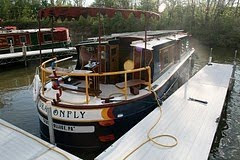On Tuesday, we headed west from Albion toward Medina. Our "Erie Canal Cruising Guide" advised us that we would see apple orchards along the route.
This guide was published in 2006, and a lot of
the information about docks, restaurants, and cruising amenities is out of date.
So we took the advisory about orchards with a grain of salt. But this time the guide was right.
 Once we left the stately brick
and sandstone architecture of Albion behind, we were cruising through farmland—vast
cornfields and expanses of soybeans, clusters of silos, the occasional tractor.
Once we left the stately brick
and sandstone architecture of Albion behind, we were cruising through farmland—vast
cornfields and expanses of soybeans, clusters of silos, the occasional tractor.  |
| Orchards along the Erie. |
And then, apple orchards! Orchards everywhere, the trees studded with yellow and
red fruit that glowed in the sunlight.
So much has changed in this region (called the Niagara Frontier)
since the Erie Canal was first dug in 1825. But apple growing has been a constant.
The climate here is perfect for apple growing: long summer
days, and cold winters moderated by proximity to Lake Ontario.
Before the canal
went in, it cost $100 a ton to ship apples to city markets by wagon—a
prohibitive cost.
After the canal opened, you could ship apples for just $6 a
ton--a good deal for growers. By 1845, Niagara County was the
largest apple producer in the United States.
From the first, many of those apples shipped out of the Niagara Frontier made their way to urbanites in New
York City.
 |
| This "Big Apple" in Medina is about 10 feet tall! |
Apples Upstate, Big Apple Downstate?
You might guess there's a connection between all the apple growing upstate, along
the canal, and the nickname of “Big Apple” for the big city downstate.
But you would be wrong.
Etymologists who’ve traced the name "Big Apple" say it was a slang term for any big city, used in the world of horse racing in the 1920s.
No connection to those mules hauling apples along the Erie in the 1820s.






No comments:
Post a Comment